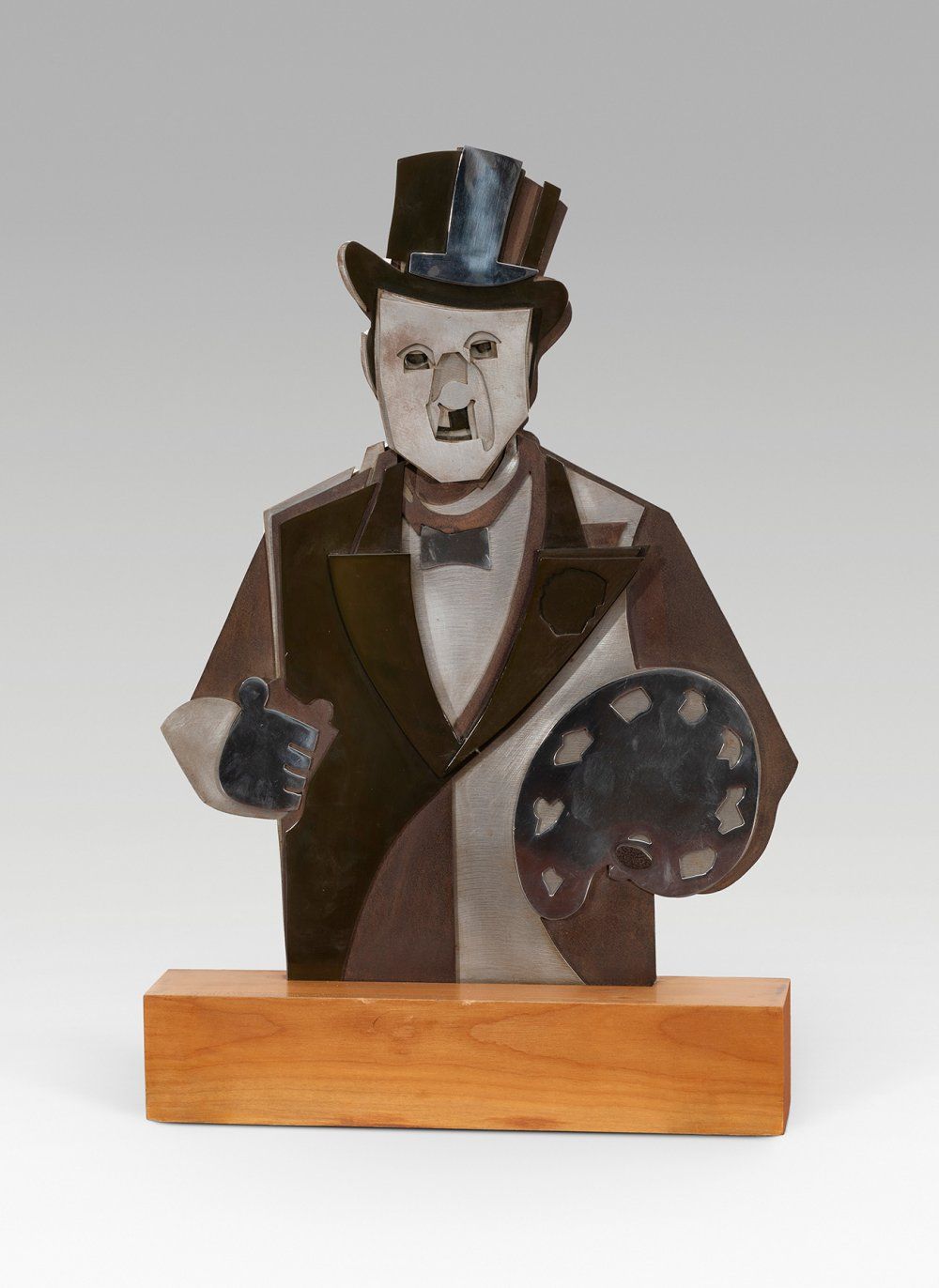Description
EDUARDO ARROYO (Madrid, 1937-2018). "Ramoneur (Chimney sweep)", 1985. Sculpture made of steel plates superimposed in different finishes on a wooden base. Sizes: 43 x 65 x 9 cm. In 1980 Eduardo Arroyo produced his series "Los Deshollinadores" (The Chimney Sweeps). In it he shows his elegant characters with the traditional clothing of the trade: black uniform and matching top hat. Arroyo began his career in journalism, finishing his studies in 1957. He then left for Paris, fleeing the stifling Spanish political climate of the time. Although his first vocation was as a writer, a task he continues to pursue to this day, by 1960 he was already making a living as a painter. That year he took part for the first time in the Salon de Peinture Jeunesse in Paris. His critical attitude towards dictatorships, both political and artistic, led him to take controversial initiatives. He opted for figurative painting at a time when abstract painting was overwhelmingly dominant in Paris, and his early themes were reminiscent of "black Spain" (effigies of Philip II, bullfighters, dancers), worked in a caustic and unromantic manner. At the beginning of the 1960s his plastic vocabulary moved under the American influence of pop art, and in 1964 his break with informal art became definitive. His first public impact came in 1963, when he presented a series of effigies of dictators at the Third Paris Biennial, which provoked protests from the Spanish government. That same year, Arroyo prepared an exhibition at the Biosca gallery in Madrid, which opened without his presence as he had to flee to France, pursued by the police; the exhibition was censored and closed a few days later. However, Arroyo's figurative option was slow to be accepted in Paris. The painter rejected the unconditional devotion to certain avant-gardists, such as Duchamp or Miró, which he considered to be imposed by fashions. His real interest was in demystifying the great masters and defending the role of the market as a protector and thermometer of art, as opposed to the network of museums and influences paid for with public money. In 1974, Arroyo was expelled from Spain by the regime, and would not recover his passport until Franco's death. However, his critical breakthrough in Spain was not immediate, and was delayed until the early 1980s. In 1982 he was awarded the Premio Nacional de Artes Plásticas, and anthological exhibitions were held at the Biblioteca Nacional in Madrid and the Centre Pompidou in Paris. Arroyo is currently represented at the Museo Nacional Reina Sofía in Madrid, the Patio Herreriano in Valladolid, the Museo de Bellas Artes in Bilbao, the Hirshhorn Museum and Sculpture Garden in Washington D.C. and the Museo de Arte Moderno in Lille (France), among others.
99
EDUARDO ARROYO (Madrid, 1937-2018). "Ramoneur (Chimney sweep)", 1985. Sculpture made of steel plates superimposed in different finishes on a wooden base. Sizes: 43 x 65 x 9 cm. In 1980 Eduardo Arroyo produced his series "Los Deshollinadores" (The Chimney Sweeps). In it he shows his elegant characters with the traditional clothing of the trade: black uniform and matching top hat. Arroyo began his career in journalism, finishing his studies in 1957. He then left for Paris, fleeing the stifling Spanish political climate of the time. Although his first vocation was as a writer, a task he continues to pursue to this day, by 1960 he was already making a living as a painter. That year he took part for the first time in the Salon de Peinture Jeunesse in Paris. His critical attitude towards dictatorships, both political and artistic, led him to take controversial initiatives. He opted for figurative painting at a time when abstract painting was overwhelmingly dominant in Paris, and his early themes were reminiscent of "black Spain" (effigies of Philip II, bullfighters, dancers), worked in a caustic and unromantic manner. At the beginning of the 1960s his plastic vocabulary moved under the American influence of pop art, and in 1964 his break with informal art became definitive. His first public impact came in 1963, when he presented a series of effigies of dictators at the Third Paris Biennial, which provoked protests from the Spanish government. That same year, Arroyo prepared an exhibition at the Biosca gallery in Madrid, which opened without his presence as he had to flee to France, pursued by the police; the exhibition was censored and closed a few days later. However, Arroyo's figurative option was slow to be accepted in Paris. The painter rejected the unconditional devotion to certain avant-gardists, such as Duchamp or Miró, which he considered to be imposed by fashions. His real interest was in demystifying the great masters and defending the role of the market as a protector and thermometer of art, as opposed to the network of museums and influences paid for with public money. In 1974, Arroyo was expelled from Spain by the regime, and would not recover his passport until Franco's death. However, his critical breakthrough in Spain was not immediate, and was delayed until the early 1980s. In 1982 he was awarded the Premio Nacional de Artes Plásticas, and anthological exhibitions were held at the Biblioteca Nacional in Madrid and the Centre Pompidou in Paris. Arroyo is currently represented at the Museo Nacional Reina Sofía in Madrid, the Patio Herreriano in Valladolid, the Museo de Bellas Artes in Bilbao, the Hirshhorn Museum and Sculpture Garden in Washington D.C. and the Museo de Arte Moderno in Lille (France), among others.
